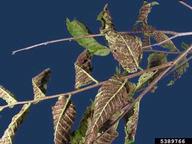Contact SprayTech for elm leaf beetle spraying at (720)248-0000.
Leaf feeding beetles are a major concern for plants. The elm leaf beetle specifically attacks types of elms. It can be difficult to stop their infestations, but there are options available.

Ronald S. Kelley, Vermont Department of Forests, Parks and Recreation, Bugwood.org
The elm leaf beetle will generate twice in a year. The first one happens in the late spring while the second one is usually in the midsummer.
Over winter, the adults will move to the bottom of the trees to seek warmth from the frost. They then emerge in the spring, moving around the trees to lay their eggs. The eggs then hatch into larvae, which will move to the base of the tree or the folds of the bark to pupate, before emerging as adults.
The larvae is yellow with two black stripes down the back. The adults are a little smaller than the larvae, with a yellow-tan color and two dark stripes down their back.
These pests cause problems at both their larvae and their adult stages. They feed on the leaves, usually along the veins and the ribs. This leads to leaves getting a skeleton-like appearance to them, and it’s the first sign that you have a pest problem.
You’ll see the damage on different types of elms, especially Siberian, English, and rock. The American elm is also becoming a popular source of nourishment for the beetles.
As the infestation gets out of control, the trees will start to go a little brown and they look unsightly. The good news is that the trees can usually recover from this as they push out new foliage.
Some even better news is that these beetles are not the reason for the spread of Dutch Elm disease, so you don’t need to act immediately if there is no infestation.
The most effective method of tackling the problem is through contact insecticides. You’ll need to spray the insecticides onto the foliage after the eggs have been laid. If you do it during the larvae stage, the creatures have already caused injury to the leaves. When you do it at the egg stage, the larvae won’t hatch.
You can also use systemic insecticides at the base of the tree. This will allow the roots to soak in the insecticide. There are also options to use banding or injecting the insecticide into the tree. The leaves then become a poison to the beetles.
If you are going to opt for tree banding, you need to make sure the whole neighborhood is doing this. You also need to remember to do it in the summer as well as the spring due to the two generation cycles a year.
SprayTech offers elm leaf beetle spraying, preventive beetle spraying and noxious weed control.
Comments are closed.